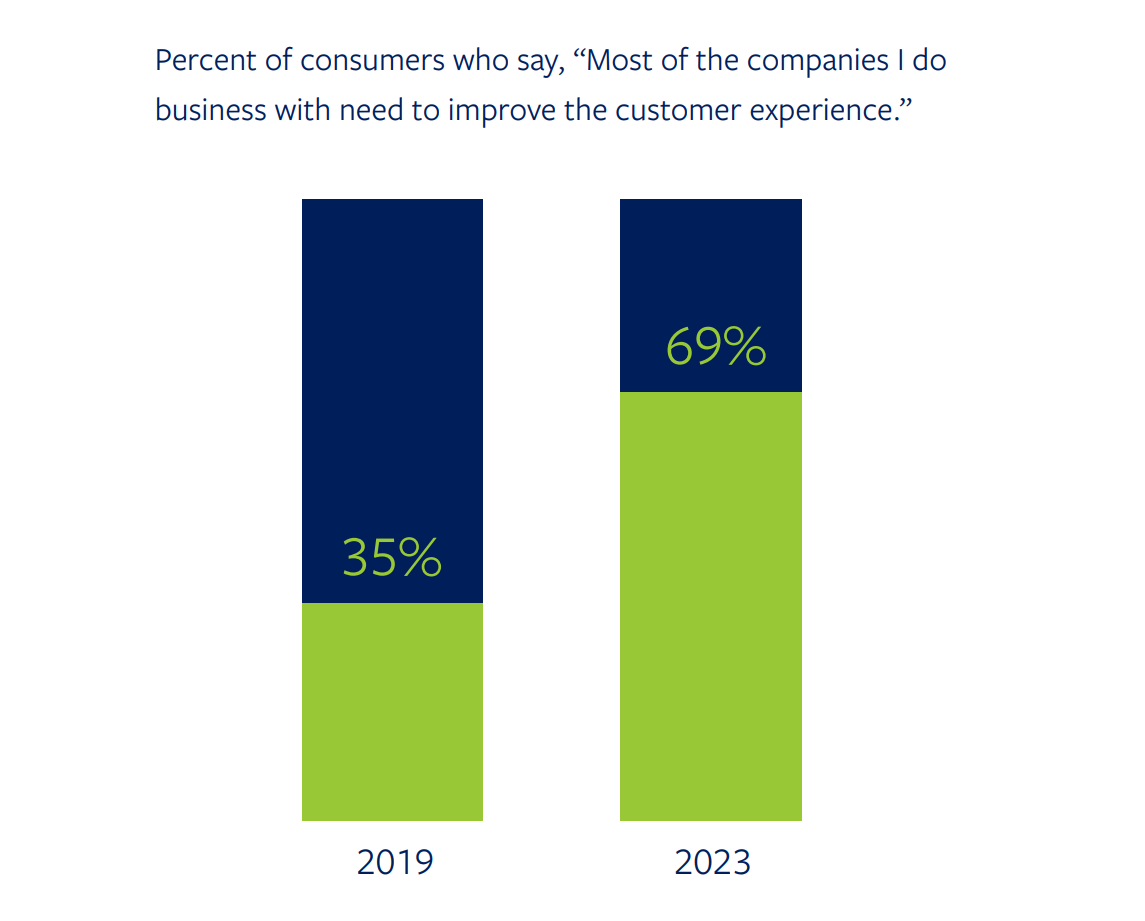The past three years have changed customer experience (CX) and communications—driving consumers’ reliance on digital as well as their expectations for what qualifies as a good omni-channel communications experience.
Consumers have been dissatisfied with the customer experiences they’ve received for several years. Fast-forward to 2023, however, and we see customer dissatisfaction levels have skyrocketed. Almost 70% of consumers surveyed in Broadridge’s 2023 CX and Communications Consumer Insights study indicated that most of the companies they do business with need to improve the customer experience. That’s doubled since 2019.
Customers vote with their wallets. More than a third of customers will cut spending with a business after a negative interaction. Before tech can deliver better interactions and engagement, companies need to build—or even rebuild—their infrastructure to support it.
The personal touch through mass personalization
It is critical for companies to consider the role communications plays in customer perceptions and their overall experience. In fact, about three in five consumers judge a company’s level of innovation based on the communications they send.Consumers don’t want cookie-cutter communications: They want more personalization. Eighty-one percent of consumers want businesses to customize their experience based on what the company knows about them. This expectation has led to frustration for consumers: only 28% say companies are “doing great” at customizing their experiences based on the data they have.
Consumers are looking for a hyper-personalized experience, which requires companies to structure their data and communications in a way that supports personalization at scale. Companies know they need to deliver this kind of experience, but most won’t accomplish their goals unless they do the behind-the-scenes work of rebuilding their technology.
Digital enhancements are increasing customer satisfaction levels
We observed an increase in digital adoption in 2022, but more consumers would go fully digital if the experience was better. In fact, 82% of consumers would go paperless—an increase of 11 percentage points since 2022.Nearly three quarters of consumers want simpler communications, such as interactive summaries of important billing or statements directly within the email companies send. Directing them to a website in order to get this information creates friction in the experience—something consumers won’t tolerate.
What are some ways companies can improve the digital experience? One example is by providing customers with personalized summary communications with goal-based performance updates, a recap of key activities, and recommendations for what to do next.
It’s a matter of trust
Clear and personalized communications may be the first key to earning consumers’ trust, but providing robust account security is a close second. Privacy and data security are of vital importance to consumers, especially when they’re evaluating the trustworthiness of any company.More than 40% of consumers stopped doing business with a company because of a hack that exposed consumer data. A majority agree that advances in digital identity security measures, like Face ID and PIN codes sent via email or text, would make them more likely to engage digitally with companies.
Building trust begins with building the technology required to keep customer information secure. Broadridge’s latest Digital Transformation and Next-Gen Tech Study finds that respondents plan to increase their investment in new technology—with cybersecurity at the fore—by 20% during the next two years.
Start with the essentials
Creating the kinds of CX experiences customers demand poses challenges, particularly for established companies with entrenched processes and systems. About 40% of companies find their path toward digital transformation stymied by rigid legacy systems.More than a third of businesses face financial constraints that impede their ability to undergo digital transformation, which is compounded by economic difficulties. Similarly, an equal percentage struggle to strike a balance between innovative pursuits and daily operational tasks. These issues are partially driven by a scarcity of the expertise and talent necessary for technological advancement.
In today’s environment of limited budgets and resources, businesses don’t have to build their own custom solutions to address CX and communications challenges. There are customer communication management and CX leaders that can help create the solutions they need, without diverting valuable in-house resources away from their day-to-day business operations. These mutualized solutions make it easier to transform your operations and with less overhead than going at it alone.
Companies looking to satisfy consumers’ strong desire for digital enhancements can and should partner with an organization that can help them achieve their digital transformation and operational savings goals — while also taking their customer experience and communications to the next level. Doing so can not only help these businesses cut costs, but it can help them achieve a competitive edge in the marketplace by enhancing the communications experience. After all, every interaction counts.
Read next: Social Media Usage Is Greater Than Ever But Publishers Aren’t Making Much Of This Opportunity, New Study Proves
by Web Desk via Digital Information World


No comments:
Post a Comment